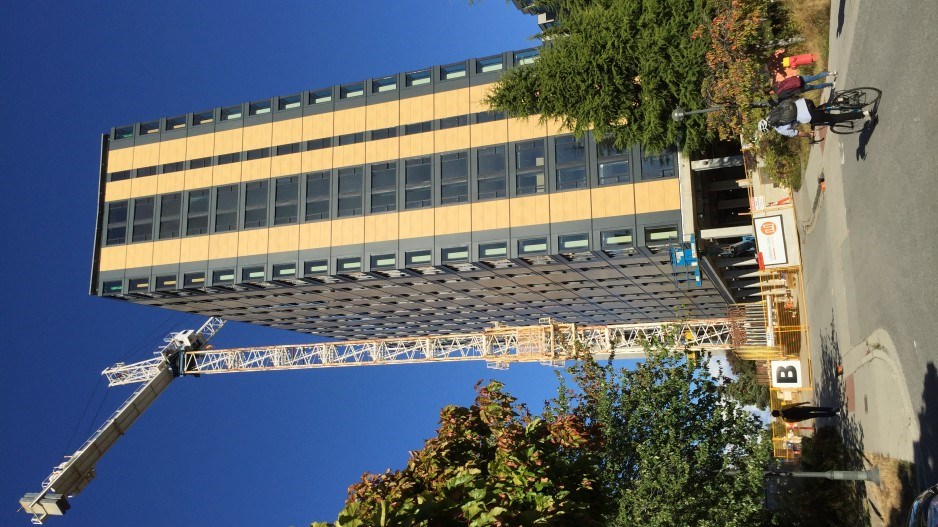B.C.'s forest sector has the potential to make a massive contribution to meeting provincial greenhouse gas targets if even relatively small changes are made in the way timber is managed, harvested and processed.
That’s the conclusion drawn from the latest research by the Forest Carbon Management Project, a multi-year, multi-agency initiative conducted under the umbrella of the Pacific Institute for Climate Solutions.
The research shows that the forest sector could account for 35% of British Columbia’s legislated goal of reducing greenhouse gas emissions to 80% below 2007 levels by 2050.
Scientists presented a portfolio of options for reaching the target at a series of seminars held throughout the province during May and June.
Researchers began by examining carbon uptake in each of B.C.’s 74 varied forest management units. Then they looked at the role manufacturing plays in storing that carbon in wood products and used the combined data to develop a portfolio of regional options.
They found that B.C. forests take as much carbon out of the atmosphere now as every other sector of the economy pumps into it. If applied, the portfolio of regional options could take 18.2 million additional tonnes of CO2 out of the atmosphere annually. That’s 35% of the provincial commitment to reduce overall CO2 emissions by 52.7 million tonnes a year.
“What we do with this wood is hugely important,” said Werner Kurz, lead researcher on the project and senior Natural Resources Canada scientist.
One green building alone – the Brock Commons hybrid wood tower at the University of British Columbia – accounts for 3,000 tonnes of CO2 that would otherwise have been pumped into the atmosphere if the 18-storey structure been made from concrete and steel.
In an interview, Kurz described the building as one small step on the manufacturing side that illustrates how B.C.’s forests and forest products can help achieve the provincial greenhouse gas target. In doing so, the forest sector can also help meet Canada’s commitment to the Paris Agreement on reducing the earth’s temperature.
An April 2017 report published by the Pacific Institute for Climate Solutions lays out the options for achieving the 35% target:
•Make more long-lasting products like lumber and cross-laminated timber (CLT) panels by diverting a small percentage of fibre now going into short-lived products like paper into the manufacture of CLT panels. The carbon in panels is stored longer, and the panels replace more emissions-intensive products like concrete and steel.
•Use more of the forest by removing residual wood after logging and burn it to create energy.
•Increase salvage harvesting after natural disturbances like fire or attacks by beetles.
•Harvest less timber. This option shows that harvesting 2% less timber produces a positive effect. Above 2%, CO2 emissions start to rise as more greenhouse-gas-intensive substitutes, like steel and concrete, replace wood use in construction.
•Harvest no stands of trees older than 250 years, an option that becomes less effective over time as the ability of older trees to take up carbon slows down and the risk of natural disturbances like fire increases.
“This research is important because it helps us understand what role forests might play in a climate change mitigation strategy – how forests, and the management and use of forest products, can help remove carbon dioxide from the atmosphere,” Kurz said.
The findings are a first step in identifying CO2 mitigation strategies. The Forest Carbon Management Project intends to follow up with more detailed research at the level of forest management planning units, taking into consideration transportation and road networks. The new analyses are expected to be accurate to the point that individual forest managers and wood product manufacturers can use them in their own strategies.
The main barrier to implementing the plan is that it requires an investment by society and by industry. The forest management options include strategies like replanting forests destroyed by natural disturbances, and fertilization, both of which require public funds. On the manufacturing side, getting the right fibre to the right facility can be costly. For example, the entire province of B.C. has only one plant for manufacturing CLT – Penticton-based Structurlam.
“Somebody has to bear that cost,” Kurz said. “Somebody has to cast the first stone to get this rolling.
“I think there are ways that government can play a role, both federally and provincially, in terms of changing building codes, which is already underway, and by providing other incentives or regulations that would enhance the use of these products so that it makes sense for industry to build the facilities to produce them.”
The target could be achieved at a cost of under $100 a tonne for carbon, which is currently priced in B.C. at $30 a tonne. There would also be beneficial economic spinoffs: 2,000 new jobs, an additional $284 million a year in provincial GDP and $34 million a year in tax revenue.
Forest companies have expressed interest in the findings and said they intend to review them more closely.
“We appreciate the recognition in this report that forestry is part of the climate change solution, and that building with wood is more climate-friendly than building with steel or concrete,” Susan Yurkovich, president of the Council of Forest Industries (COFI), said in an email. “We also recognize the value that forest management plays in how B.C. meets its carbon-emission targets for the long term, and how it can contribute to climate change mitigation.”
Yurkovich said COFI is particularly interested in the next stage of analyzing options at the level of forestry management planning.
“There are some assumptions that deserve a closer look as well as input from producers,” she said. “Including cost implications in the analysis is important.” •




